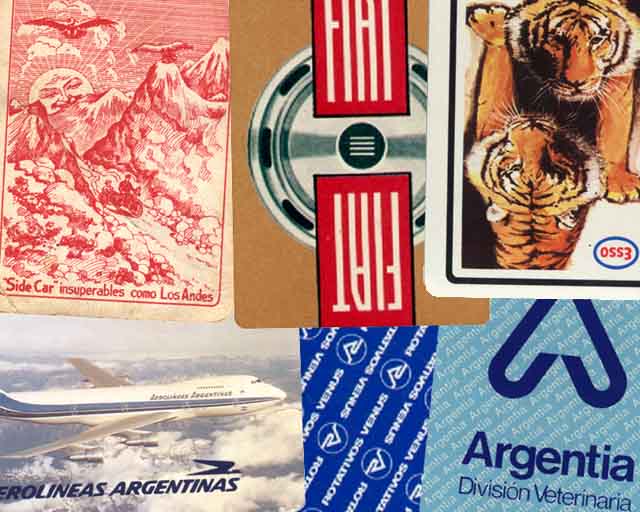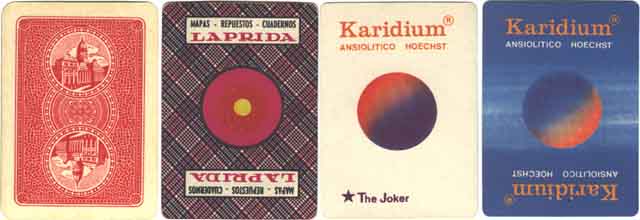Argentina Card Backs
BACK DESIGNS
The earliest playing cards had blank backs because of the difficulty of precisely aligning a pattern with the fronts of the cards when large sheets were cut into smaller units. During the eighteenth and nineteenth centuries, as printing technology improved, simple patterns of dots, geometric shapes, sprigs or other small repeating motifs were introduced.

Above: the introduction of printing blocks made from metal resulted in precise and regular back patterns of diagonally crossed lines, such as are currently used in many countries around the world. The examples shown here date from c.1950-60.

Above: commercial advertising on playing cards reflects the economic activities of the day, especially foreign industry operating in Argentina. The FIAT pack (by E. Flaiban) dates from the 1950s when private motor car ownership became feasible to the average Argentinean householder. Lately, Argentina's monetary policies have proved costly for manufacturers, exposed to cheaper competition from abroad… the 'Aerolineas Argentinas' pack was made in China.

Above: back designs from "Naipes Porteño" and "Naipes Inca" by C. Della Penna, with advertising for Laprida products, c.1960.
Special Joker and back design from advertising pack for Hoechst pharmaceutical products, c.1970.

By Simon Wintle
Member since February 01, 1996
I am the founder of The World of Playing Cards (est. 1996), a website dedicated to the history, artistry and cultural significance of playing cards and tarot. Over the years I have researched various areas of the subject, acquired and traded collections and contributed as a committee member of the IPCS and graphics editor of The Playing-Card journal. Having lived in Chile, England, Wales, and now Spain, these experiences have shaped my work and passion for playing cards. Amongst my achievements is producing a limited-edition replica of a 17th-century English pack using woodblocks and stencils—a labour of love. Today, the World of Playing Cards is a global collaborative project, with my son Adam serving as the technical driving force behind its development. His innovative efforts have helped shape the site into the thriving hub it is today. You are warmly invited to become a contributor and share your enthusiasm.
Related Articles

Jockey Club de Buenos Aires
Spanish-suited pack by Chas Goodall & Son Ltd for the Jockey Club, Buenos Aires.

Geschichte des Buchgewerbes
Geschichte des Buchgewerbes illustrated by Ludwig Winkler, published by Verlag für Lehrmittel Pößnec...

Egyptian Tarot
Egyptian Tarot inspired by ancient Egyptian art, mythology, and iconography, published by Naipes La ...

Naipes Criollos
“Naipes Criollos” Gaucho playing cards, 1995.

Naipes Cardón
Naipes Cardón designed by Mario Luis Rivero depicting traditional Argentine culture and identity, 20...

El Oráculo de la Bruja
“El Oráculo de la Bruja” fortune-telling cards, 2003.

Martín Fierro
Naipes “Martín Fierro” based on the epic poem by José Hernandez.

Naipes Parliament por Caloi
Carlos Loiseau, better known as ‘Caloi’, was a cartoonist whose designs for Parliament Cigarettes we...

Minifusor Tipo Español
Naipes "Minifusor" tipo Español published by Difusora S.A., c.1980.

Clark’s Industries
Clark’s Industries Spanish Cards, c.1975.

El Tripero
Hand-drawn semi-erotic, satirical playing cards by Lautaro Fiszman ‘El Tripero’, 2002.

59: Owen Jones (1809-74) and De La Rue
A selection of examples of Owen Jones's work printed by De La Rue.

Mordillo Skat
Mordillo Skat designed by Guillermo Mordillo, c.1979

Cartas Gitanas
The designs of these fortune-telling cards are largely taken from nineteenth century Austrian "Rural...

Naipes Garaycochea
Humorous playing cards designed by Carlos Garaycochea, Buenos Aires, c.2002.
Most Popular
Our top articles from the past 28 days


